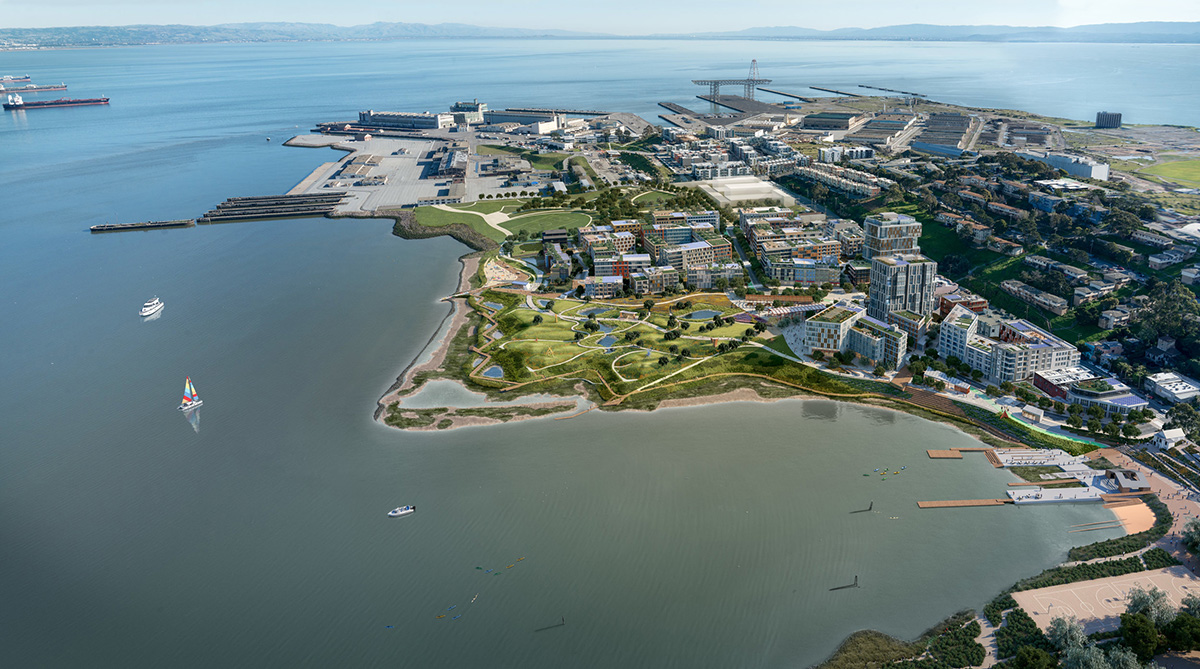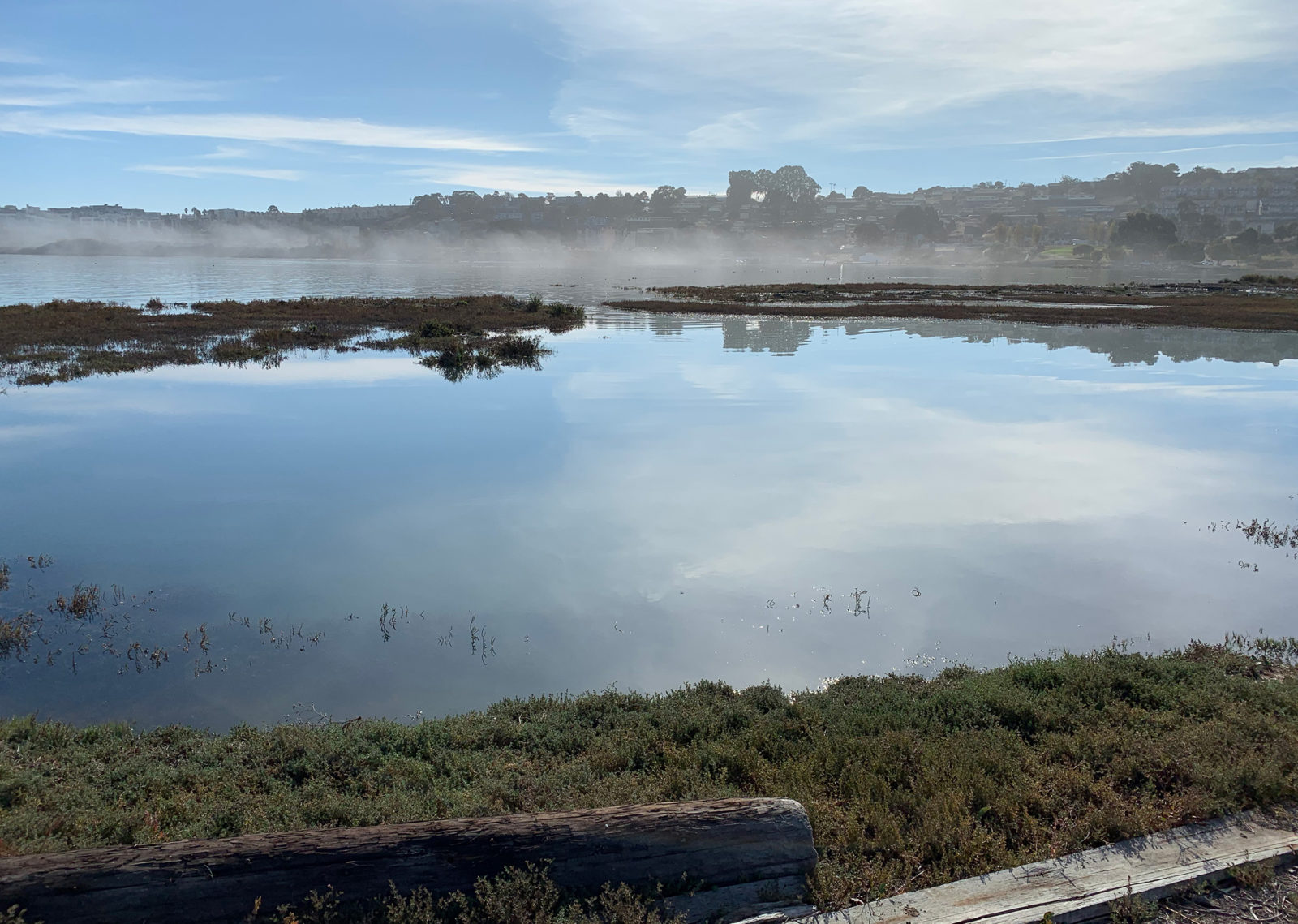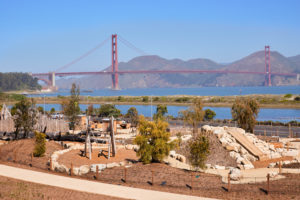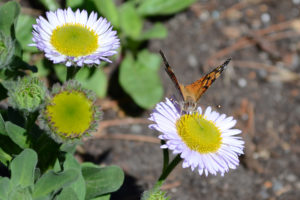This article is co-published with the San Francisco Public Press, a member-supported nonprofit news organization specializing in investigative and solutions journalism. Find out more at sfpublicpress.org.
If anyone should be excited at the prospect of $29 million in funding for the development of a waterfront park in India Basin, it’s Patrick Marley Rump – yet he’s not.
The longtime Bayview resident supports the future India Basin Waterfront Park, and he hopes that money — part of a $487 million parks and open space bond measure — gets approved by San Francisco voters in November. Rump sees in this 3.7 acres of land the potential for his nonprofit, Literacy for Environmental Justice, to take people on kayak and canoe trips from India Basin to the new state campground at Candlestick Point. To him, this new park will put the “Bay” in the Bayview — for its residents.
But as Rump thinks about the commercial and residential complex that will be built next to the park, he’s skeptical. The neighboring project will raise air pollution to hazardous levels during and after construction, according to the environmental impact report. For a community full of people who, like Rump, suffer from asthma, this is not acceptable to him.
Is the project “about selling new homes and making the area look beautiful for developers, or is it about making this site accessible for the community?” he asks. “What’s driving this project?”
The Bayview has the city’s attention – for better or for worse, depending on whom you ask. If voters approve the bond, it will help fund a park at 900 Innes Ave., the first waterfront land the city’s Department of Recreation and Parks has ever owned. It’s also a former small-craft shipyard site founded in the late 1800s by English, Dutch, German and Scandinavian boat builders.
High Line Comparisons
There are lofty hopes for this area. Department Director Phil Ginsburg chooses his words carefully when trying to come up with an analogy for what this park, and the greater shoreline, is to become. Crissy Field comes up. He mentions the High Line in New York City, which redeveloped an abandoned railway into a heavily visited park. But the High Line also touched off a real estate boom that raised rents and pushed out long-time residents.
Ginsburg pledges India Basin will be different. He points to the involvement of many community groups in the planning process as proof. These groups are consulting on the design of the park, creating public art and developing nature, outdoor and arts programs in the area for local youth.
“This is a park that we want to be designed by, built by and operated by and for the benefit of the Bayview community and specifically the Black community,” Ginsburg said. “This is the Bayview’s moment.”
But the adjoining property at 700 Innes is what concerns Rump and other community members. This part will be built by Build LLC, a developer that specializes in mixed-use projects. It will add 1,575 units of housing, with 25 percent priced below market rate. What concerns Rump and others is the final environmental impact report, which said the air pollution levels from particulate matter — especially PM2.5, the most hazardous — will be at unsafe levels even after construction, due to projections of higher traffic levels. The Bay Area Air Quality Management District has also raised concerns over these impacts.
Poor air quality — from industry, traffic and construction — is a major issue for the Bayview. The community was cited in a 2017 report by the Department of Public Health as one of four neighborhoods in the city with the highest rate of preventable hospitalizations related to air pollution levels. District 10 Supervisor Shamann Walton — who also represents San Francisco at the air quality district— said Build will need to come up with a mitigation plan.

San Francisco’s Grand Plans
The project is a big part of the city’s plans for bringing economic growth to a long-neglected area. In March 2019, the John Pritzker Family Foundation awarded the city $25 million for the India Basin Waterfront Park, the single largest private donation for any park in city history.
“This park is an important investment in the Bayview Hunters Point community and a big step in creating equity when it comes to healthy neighborhoods in our city,” Mayor London Breed said in a statement announcing the award. With that funding plus state, local and grant money, the park has raised close to $47 million.
The city has a lot of work to do with that money. It plans to renovate and knit together two other existing open spaces — the India Basin Open Space and the India Basin Shoreline Park — via the Blue Greenway, 13 miles of trails connecting parks from China Basin to Candlestick Point along San Francisco’s southeastern waterfront, that will add roughly 10 acres of open space to the trail system.
Right now, the park lot is fenced off. It is an officially designated brownfield, land that contains hazardous materials. After shipbuilding ceased, the site was used primarily as a dumping ground for heavy industry and construction. An EPA assessment found the soil contains heavy metals such as mercury and lead, along with oil and polychlorinated biphenyls, chemicals used in coolants and lubricants that are considered by the EPA as probable carcinogens. San Francisco has received funds from the federal program to help pay for the planned cleanup of the land.
The plan for the cleanup states that up to five feet of shoreline soil and another four feet of sediment will be removed and replaced with clean soil and sand. All contaminated soil and sediment is to be hauled away to what the city calls “appropriately permitted” landfills. All replacement soil, along with soil samples taken during development, are supposed to be tested to make sure they’re clean.
On the actual waterfront, the plan calls for creating nearly a half-acre of wetlands and tidal marsh. This is all in line with Rump’s priorities for his LEJ members to get workforce training in restoration projects. He also sees it as safeguarding the low-lying community from sea level rise. Putting city money into the cleanup and restoration “ensures it, and a lot of people need to get to work,” he said.
The issue of cleaning up and redeveloping toxic sites is an open wound for the Bayview. The biggest development in the community — the Hunters Point Shipyard — has been on pause for three years due to fraudulent tactics by Tetra Tech, the contractor the Navy hired to do the cleanup.
Supervisor Walton said he’s mindful that this botched effort has sown distrust within the Bayview for cleanup operations on future development projects like India Basin, as well as overall distrust of the city. “We have to make sure that it’s going to provide an environment where people are safe and able to live, and you’re not going to be moving forward unless that is satisfied,” Walton said.

Finding the Air to Breathe
Some distrustful residents aren’t sold on the mixed-use development proposed for the land next to the park.
The report stresses the need to reduce truck trips during construction and the use of public transit to get people out of cars. But the pandemic has threatened public transit infrastructure. San Francisco Municipal Transportation Agency cut MUNI service to just 17 routes during the shelter-in-place, and budget shortfalls could mean that up to 40 of its lines are suspended for years, or retired.
Even before COVID-19, the Municipal Transportation Agency called the Bayview’s public transit options substandard in a transportation plan released in February. The agency described the T Third rail service as slow and unreliable, stating that the community is served “by some of the most-delayed transit lines in San Francisco.”
The Bayview is home to the city’s largest Black population, and this community has increasingly fallen behind economically while the rest of San Francisco has thrived.
The MTA plan finds that nearly a quarter of Black households in the Bayview earn less than $30,000 a year. By contrast, 60 percent of white households in the Bayview earn more than $100,000. The Bayview as a whole had an unemployment rate of 10.1 percent before the pandemic, five times higher than the rest of San Francisco.
The India Basin project has promised jobs and affordable housing, but at a cost to their health some in the community like long-time resident Leaotis Martin are unwilling to accept. “It hurts me to see a neighborhood with kids that have asthma and can’t play like other kids,” Martin said, referring to the high levels of asthma among his fellow residents. “They’re supposed to protect people first, period.”
The final environmental impact report called the project’s expected impacts on air quality “significant and unavoidable with mitigation.” Nonetheless, the city’s planning department certified the environmental impact report in July 2018, and the Board of Supervisors unanimously approved it in October of that year.
Worries About Mitigation
The Bayview is considered a health-vulnerable zip code by state officials due to its high levels of respiratory illness and related medical conditions. Because of this, a more stringent standard for particulate pollution was applied for the India Basin project than is used by the state or federal government.
“Any increase in air pollution above the current disproportionate burden in eastern San Francisco is unacceptable,” Greg Nudd of the Bay Area Air Quality Management District wrote in a letter to the Board of Supervisors a year after they approved the project. Nudd, a deputy air pollution control officer, said his agency is trying to provide direction to San Francisco to help minimize the effects of the construction, but ultimately the air quality district has no authority over the city on any project.
That means it’s up to city officials — department heads, the mayor, the Board of Supervisors — to ensure the project doesn’t worsen health in the neighborhood. This doesn’t inspire confidence among people like Michelle Pierce.
Pierce, executive director of the environmental justice nonprofit Bayview Hunters Point Community, said the planning department is not to be trusted. She pointed to its track record in approving projects like the Transbay Transit Center, which was closed down shortly after opening when workers discovered a large crack in a beam holding up the roof, or the Millennium Tower, which has been sinking since it opened.
“Nobody is holding them accountable, even for that,” Pierce said. “And when these things do not affect the wealthiest people in the city … what do you think is going to happen to us? I can tell you. It’s a form of genocide. You’re either removing us via gentrification or you’re killing us with the environmental stuff, and nobody’s talking about it like that.”
City leaders say this time really will be different. “I do agree there’s been lots and lots of broken promises in the southeast and in the Bayview,” said parks director Ginsburg.
Ginsburg said India Basin development has been slow and deliberate because they’re working to involve the community. “It’s not improving a space that’s negative; it’s displacing people as a result of that improvement that’s negative,” he said. “So how do you improve and invest in without displacing or at least mitigating displacement? That’s the secret sauce to this project.”
Managing Expectations and Uncertainties
Ginsburg points to the hiring of Jacqueline Flin, director of the A. Philip Randolph Institute, to manage the equitable development program for the project. “We want the community’s expertise, and we’re paying for it,” Ginsburg said.
Flin is contracted through the San Francisco Parks Alliance to turn the promise of equity into a reality. “We’ve been working with a diverse group of community members to define the categories that we’ll need to address to create equity,” she said.
That group is the executive leadership team, made up of 20 members from various walks of life in the neighborhood that Flin has worked in for roughly 20 years. It includes representatives of the Public Housing Tenants’ Association, the Bayview Historical Society, several youth advocacy organizations and the multiple ethnic communities that make up the district, including Chinese, Latino and Pacific Islander. Flin said the team is working to address key issues including arts and culture, youth development and economic development. It is also planning financial literacy training to inform people about resources to get a loan to purchase a new home, or to help them keep their current home, as part of the plan to make the development’s benefits more equitable.
The bond money, said Flin, would help underwrite the park and the programs her team is designing. “It’s going to allow us to put some of those ideas into concrete commitments and into what they’ll see in the future park,” she said.
Alejandra Chiesa of the Trust for Public Lands, who has worked on park development projects in other cities, said this extent of involvement in issues like housing security are unusual for a city’s parks department to take on but can help a community see a park as an asset — not a threat. “There are park projects where it’s, ‘We don’t do housing. We don’t do transit. We just do parks,’” she said.
Learning From Past Success
Chiesa points to the renovation of Bayview’s Hilltop Park, located just a few blocks from India Basin, as a small success story when it comes to listening to as well as following through with a commitment to work with a community. She recalls early meetings about what to include in the park and how it should look and, instead, she heard from the community that they wanted jobs.
Since this was a small project, they couldn’t promise a lot, she said. But ultimately, 10 to 12 people went through a jobs training program with the contractor, and two to three people were hired on to build the park.
This success is something that could scale up to India Basin, notes Chiesa. She said Ginsburg’s commitment to working through other departments within the city can get things done in a way that supports the community.
A companion report on the bond from the city makes a case by analyzing open space measures passed during and shortly after the Great Recession. These bonds helped create some 9,500 jobs. “Investing in public facilities and infrastructure is an important and necessary step that San Francisco can take to put thousands of people to work and help accelerate our economic recovery,” says the report.
Still, what happens if the bond doesn’t pass? Rec and Park spokeswoman Madison Sink answers in part by counting what’s covered by the $47 million the city already has in hand. This would include the remediation of the land and shoreline as well as the design of the park.
There’s no contingency plan. Nonetheless, the park development will happen, said Sink. “Rec and Park and our partners would need to secure funds from other sources, and that could slow things down,” she wrote in an email.
Lyslynn LaCoste, director of the nonprofit BMAGIC, a Bayview community organizing group, is OK with the wait. She noted that getting the Bayview access to other parts of India Basin has taken many years — all worth it since it allowed the community a voice in steering the development. “We want to see the work move forward, and we want to make sure the folks that have lived in this community for generations are the ones that are benefiting from this future project,” said LaCoste.





